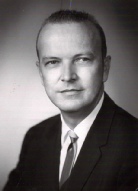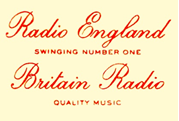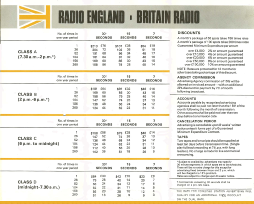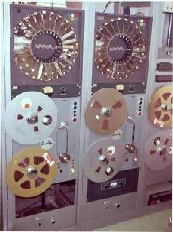© 2014-


Britain Radio - History
A lavish press conference in London on 20th April 1966 announced the launch of yet another offshore radio project -
The new project planned to start broadcasts from off the Essex coast by the end of April, but in fact test transmissions for the two new stations -
Although based on the same s hip the twin stations were to be radically different from eachother and from any other offshore or landbased stations then on the air. Radio England, which planned to compete in the market area already covered by Radios Caroline, London and City, was to be a brash, all-
hip the twin stations were to be radically different from eachother and from any other offshore or landbased stations then on the air. Radio England, which planned to compete in the market area already covered by Radios Caroline, London and City, was to be a brash, all-
Behind this ambitious project were some of the original backers of Radio London -
ambitious project were some of the original backers of Radio London - roken away from Radio London early in 1965 after fundamental boardroom differences over that station's programming style and format. Money was to be no object!
roken away from Radio London early in 1965 after fundamental boardroom differences over that station's programming style and format. Money was to be no object!
A management company was formed for the new project - f airtime. Howver, the company failed to proactively sell airtime which quickly led to financial problems for both Radio England and Britain Radio.
f airtime. Howver, the company failed to proactively sell airtime which quickly led to financial problems for both Radio England and Britain Radio.
At the beginning of 1966 the project’s ship Olga Patricia (later re-
However, shortly after the ship sailed from Miami the aerial mast collapsed and there then followed a series of delays and a display of gross inefficiency in dealing with problem. The Laissez Faire spent two weeks in Lisbon then Continental Electronics then suggested that the ship should sail to her proposed anchorage off the British coast and the work would be carried out at sea. The vessel sailed for her anchorage off Harwich and lay silently at anchor while Continental Electronics arranged to bring equipment from Dallas and from West Germany to rebuild the aerial system.
Test broadcasts eventually started from the ship on 3rd May. To begin with Britain Radio broadcast on 227m (1320kHz) although the potential transmitter power of 55Kw was not achieved due to technical problems. For most of May 1966 test broadcasts continued sporadically with regular interruptions and breakdowns while the equipment was adjusted and modified.
On 3rd June 1966 the Italian Government complained that the transmissions from Radio England were interfering with its Roma 2 station and as a result Radio England swapped frequencies with its sister station, Britain Radio, while transmitter power was reduced significantly during the evenings. The Italian Government also complained to Panama about interference from the two stations on board the Laissez Faire. As a result the Laissez Faire's registration was withdrawn and the vessel remained a stateless ship for two months until she was re-
Regular programmes from Britain Radio eventually started on 16th June 1966 on a wavelength of 355m (845kHz -
In contrast to Radio England its sister station, Britain Radio catered for a quieter, older audience. This station also brought with it a set of custom-
Although it was supposedly catering for the same audience sector as Radio 390, Britain Radio adopted an entirely different programming style. Instead of the 15 and 30 minute segments specialist music, which Radio 390 had so successfully tailored for its audience, Britain Radio adopted the same 'horizontal' format as its pop rivals using three or four hour long programmes, but with the DJ's playing easy listening music instead of Top 40 pop. Unfortunately audiences and advertisers were not won over -
Britain Radio carried the first political advertisement broadcast on a British offshore radio station on 29th September 1966, when the Ratepayer's candidate in a by-
the first political advertisement broadcast on a British offshore radio station on 29th September 1966, when the Ratepayer's candidate in a by-
Both stations on board the Laissez Faire made use of an automated Carousel unit -
This unit, similar in principle to a juke box, but working with tape cartridges instead of discs, could be use d to provide either non-
d to provide either non-


Click on picture to enlarge
Don Pierson
The ‘Hallmark of Quality’ jingles set the right tone for the station’s easy-


The first Rate Card for Britain Radio and Radio England
Click to enlarge

The Guardian
21st April 1966
Britain Radio and Radio England testing on the same wavelength, June 1966

The automated Carousel unit on board Laissez Faire

History
Key Dates
Ship and Location
Technical
Staff
Programmes






These are the only tape machines I have seen that could play in both directions. Certainly a heavily mechanised machine to achieve constant unattended programming. The rotation of the carousel cartridge player was far from quiet and could be used on demand (remote control) or in sequence with the three tape machines. A spool of male vocals, female vocals and instrumentals was normal, each track being back-
Great memories.
Tom Dannaher
Bill Vick
Treasure Chest


Miami News
1st April 1966
Courtesy Mike Barraclough

Daily Mirror
28th September 1966




Back to Britain Gallery


Back to Britain Radio
